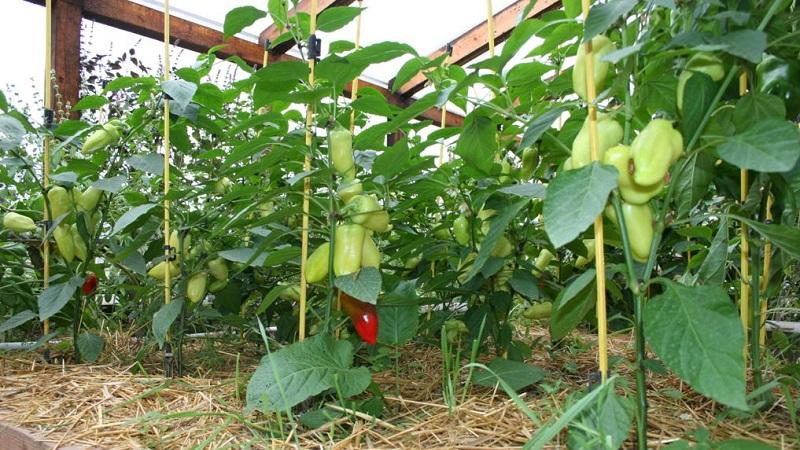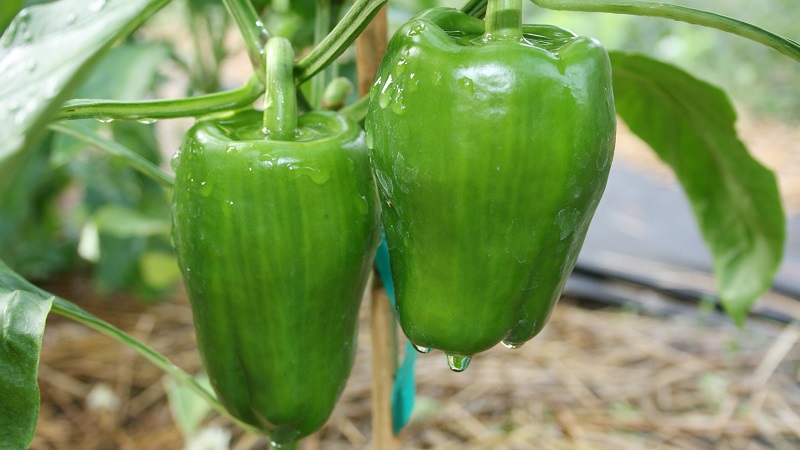How and what to feed peppers in a greenhouse in August: the best fertilizers and recommendations for their introduction
A properly selected greenhouse pepper dressing is one of the guarantors of a good harvest. Gardeners combine mineral and organic fertilizers, use folk remedies. Particular attention is paid to the application of fertilizers in August - this month there is an active growth of fruits.
The content of the article
Top dressing of pepper in the greenhouse for months

The timing of fertilization in greenhouses coincides with the timing of top dressing of pepper in the open field.
In June, planting holes are plentifully shed beforehand so that the soil is moistened to a depth of 15 cm.In each of them when landing 150 g of compost, 5 g of urea, 5 g of potassium sulfate are poured.
Two weeks later, they are fed with a solution consisting of 15 g of ammonium nitrate, 5 g of superphosphate and 20 g of potassium sulfate per 10 L of water. Consumption rate - 1 liter of solution for each bush.
In July, the soil is moistened twice a week. 10 g of urea, 25 g of potassium nitrate, 25 g of superphosphate, previously dissolved in warm water, are added to a bucket of water. Pour 1 liter of nutrient solution under each bush.
Reference. In August, nitrogen fertilizers are not used so that nitrates do not accumulate in the fruits.
Then potash and phosphate fertilizers continue to be applied. Useful fertilizing from wood ash, which is sprinkled on the ground around the bushes.
How to feed
When growing pepper, fertilizers are applied throughout the entire growing season. At different stages of development, the composition of the introduced elements changes.
In August, pepper has an active period of ovary formation and fruiting. During this period, he especially needs phosphorus, potassium, boron, calcium. Most often, calcium nitrate is used - it is sprayed over the leaf and watered at the root.
Reference. It is not recommended to combine calcium nitrate and superphosphate. The reaction of interaction between them will negatively affect the growth of the bushes.
At this stage of growth, humate solutions are useful to the plant. They strengthen the root system and help to enrich the plant with nutrients.
Ready dressing
During the period of ovary and fruit formation, it is recommended to use complex mineral fertilizers: Agricola, Solution, Novofert Universal, Fertika Lux and others. Additionally, trace elements are included in their composition: boron, magnesium, calcium, also amino acids, polysaccharides. Fertilizers are applied by irrigation under the root and foliar method. They are especially effective in delaying flowering.
Folk methods
Many gardeners use infusion of banana peel, since it has a high concentration of potassium. The peel of five bananas is poured into 5 liters of water and insisted for a day, and preferably two. The solution is poured under the root.
Eggshell - a source of calcium. It is crushed to a powdery state and introduced into a compost pit.
Prepare "green tea" from equal parts of herbs: nettle, coltsfoot, plantain, dandelion. The herbs are poured with water and insisted for five days. Then diluted with water 1:10 and watered each bush.
Fertilization with yeast is effective, promotes active growth of pepper. Take 20 g of yeast, 30 g of sugar and 1 liter of water. Insist in a warm place until fermentation appears. Then the composition is diluted in 10 liters of water and applied at the root.
Iodine protects culture from many diseases... It is added to irrigation water at a concentration of 1:10.Sometimes whey or kefir is added to this composition.
Features of feeding depending on the period

At different stages of development, the plant requires certain trace elements:
- when planting seedlings in a permanent place - nitrogen;
- when growing green mass - nitrogen, potassium, boron;
- for flowering - phosphorus, potassium;
- with the formation of the ovary - phosphorus, potassium, calcium.
After landing
To obtain a decent harvest, fertilizers are applied from the moment the seedlings are planted into the soil. If pepper seedlings receive all the necessary substances in the early stages of the growing season, later they will grow strong, resistant to various diseases, with good immunity.
The first feeding is carried out during the period when two pairs of true leaves appear on the seedlings. At this time, seedlings need fertilizers with a predominance of nitrogen and less potassium. The first is necessary for the growth of shoots, leaves... With its lack, the seedlings will be elongated and weak.
For the first feeding, urea is used - it contains 46% nitrogen. For watering, a solution is prepared in which the concentration of fertilizer is half that recommended for adult bushes, that is, 10 g of urea per 5 liters of water.
Nitrogen fertilizers are used more often, in which nitrogen is in the form of nitrates: calcium and sodium nitrate.
Potassium stimulates the growth of the root system of immature seedlings. If nitrogen affects the volume of green mass, then potassium improves its quality. The element is introduced using potassium sulfate, potassium nitrate.
Of organic fertilizers used:
- Infusion of chicken manure, which is diluted at the rate of 100 g of substance per 5 liters of water.
- Vermicompost at a concentration of 0.5 kg per 10 liters of water.
- Wood ash. It contains a large amount of potassium. A tablespoon of ash is poured with a liter of water. The next day, you can water the seedlings.
The second feeding is performed two weeks after the first. Seedlings during this time have time to get stronger. In this case, complex fertilizers are used, where phosphorus is contained in a lower concentration.
If humus was used when composing the soil, the amount of nitrogen in the second top dressing is reduced.
Before fertilizing (1-1.5 hours), the soil is watered.
Important! Before adding microelements, the soil is pre-moistened so as not to "burn" the young roots.
Foliar dressing
Foliar dressing is an addition to root watering. In addition to the main ones, they are supplemented with essential trace elements such as manganese, boron. Leaf feeding is especially effective when the plant has begun to wilt.
Application of leaf dressing in greenhouses does not depend on weather conditions - in contrast to dressings carried out on the plots.
Foliar feeding is carried out with the same fertilizers as when watering the soil. But for spraying, a solution is prepared, the concentration of which is half that. This is necessary so that the composition does not burn the leaves.
Foliar dressing is carried out in dry, calm weather in the morning or evening, so that the sun's rays do not damage the wet leaves.
During fruiting
The next feeding is carried out during the formation of the ovary. At this stage, drugs containing potassium, phosphorus, magnesium, calcium are used. The flowering and fruiting process depends on the amount of potash fertilizers applied. Lack of potassium leads to poor flowering.
It is replenished by irrigation with a carbamide solution (5 g per 10 l of water). The introduction of nitrogen is stopped so that there is no excess of nitrates in the ripening fruits.
When the first fruits appear, mineral dressings are replaced with organic or "folk" ones. For cultivation in greenhouses, fertilizer "Ecohuminat" is used based on natural humus. This fertilizer also stimulates the formation of the ovary.
Half a teaspoon of the product is poured under each plant, then poured with water.
Calcium is introduced into the soil in the form of crushed eggshell.
Top dressing if peppers do not grow well
If the pepper bush has small leaves and few shoots, then the fruits will be small. This is due to the process of photosynthesis, as a result of which the necessary nutrients are supplied to the plant through the leaf mass. Poorly developed bushes need nitrogen fertilization. In this case, it is better to use complex fertilizers containing nitrogen, potassium, phosphorus, but with a large predominance of the former.
Ammonium nitrate is also used (10 g of nitrate per bucket of water), urea. The second does not burn the leaves when spraying.
Weak bushes are fed with a solution of cow manure (1:10) - it is used with caution, as it can cause root rot.
Pepper does not like acidic soils - they are neutralized by the introduction of chalk. In addition, chalk is a source of calcium, which plants need when growing their root system.
How to properly feed peppers in a greenhouse

If at the end of summer the pepper bushes grow healthy, bloom profusely and give a lot of fruits - do not get carried away with mineral fertilizers.
If the bush is actively overgrown with green mass, and flowering is delayed or there are few flowers, stop using nitrogen-containing fertilizers and switch to fertilizers, which are dominated by phosphorus: superphosphate, double superphosphate. To prevent the ovary from falling off, add boron - 5 g of boric acid to a bucket of water.
To speed up the process of fruit ripening and achieve harvesting at the same time, dressings containing potassium and phosphorus are used. For example, potassium monophosphate, potassium-phosphorus preparation "Autumn", which also includes calcium, boron, magnesium. To replenish potassium and phosphorus, these fertilizers are applied in an amount of 10 g per 10 liters of water.
In August, the pepper has an active fruiting period. In greenhouse conditions, a larger crop is harvested from a pepper bush than from a grown in the open field. This is due to the fact that the required level of heat and humidity is maintained in the greenhouse. During this period, pepper is especially needed for phosphorus, potassium, boron, magnesium, zinc, calcium.
Alternate fertilizing with mineral fertilizers with the introduction of organic matter.
Attention! The composition of fertilizers should not include chlorine, since in a closed ground it is weakly washed out of the soil mixture.
During the period of fruit formation, the bushes are sprayed with a solution of calcium nitrate (0.2 g per liter of water) or a chelated form of calcium (50 ml per 10 liters of water) - it is absorbed by plants faster. When watering, calcium nitrate is applied in the same concentration as when spraying.
Organic matter is introduced with the help of herbal infusions and poultry droppings, which are diluted with water in a ratio of 1:20. Banana peels are often used, soaked in water for at least a day.
Frequency and abundance of top dressing
The first feeding in the greenhouse is carried out 14 days after planting the seedlings. In this case, poultry manure or cow dung is used, mixed with water in a ratio of 1:15. 0.5 l of solution is added under each bush.
After the onset of flowering, a second feeding is performed. For this, minerals are added to organic matter.
The third feeding is carried out at the time of fruit ripening and the first harvest.
Top dressing in August is carried out once a week. 1 L of the prepared nutrient solution is added under each bush.
Useful Tips
After watering, mulching with organic matter brings good results: compost, vermicompost, humus. With subsequent watering, they will gradually nourish the root system of the peppers.
It is useful for fruiting in August, while loosening the soil, pour wood ash around the bush - it has a high potassium content, while the soil is moistened, it will nourish the plant.
Conclusion
Now you know how to feed the peppers in August in the greenhouse, and what to do if feeding with folk remedies does not help. The main thing is to follow simple rules, feeding the plants with those fertilizers that are most necessary for them during a particular growing season.
Be attentive to the peppers, surround them with care and quality nutrition, and they will certainly thank you with a tasty and rich harvest!